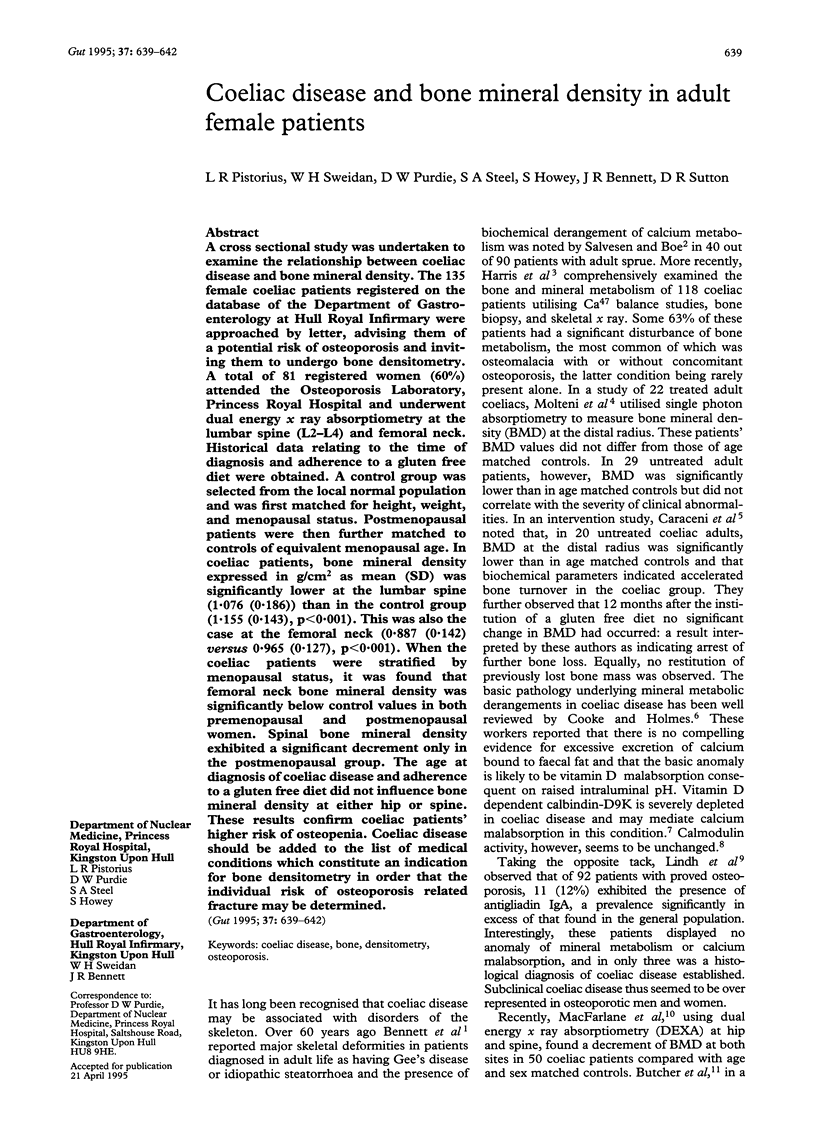Abstract
A cross sectional study was undertaken to examine the relationship between coeliac disease and bone mineral density. The 135 female coeliac patients registered on the database of the Department of Gastroenterology at Hull Royal Infirmary were approached by letter, advising them of a potential risk of osteoporosis and inviting them to undergo bone densitometry. A total of 81 registered women (60%) attended the Osteoporosis Laboratory, Princess Royal Hospital and underwent dual energy x ray absorptiometry at the lumbar spine (L2-L4) and femoral neck. Historical data relating to the time of diagnosis and adherence to a gluten free diet were obtained. A control group was selected from the local normal population and was first matched for height, weight, and menopausal status. Postmenopausal patients were then further matched to controls of equivalent menopausal age. In coeliac patients, bone mineral density expressed in g/cm2 as mean (SD) was significantly lower at the lumbar spine (1.076 (0.186)) than in the control group (1.155 (0.143), p < 0.001). This was also the case at the femoral neck (0.887 (0.142) versus 0.965 (0.127), p < 0.001). When the coeliac patients were stratified by menopausal status, it was found that femoral neck bone mineral density was significantly below control values in both premenopausal and postmenopausal women. Spinal bone mineral density exhibited a significant decrement only in the postmenopausal group. The age at diagnosis of coeliac disease and adherence to a gluten free diet did not influence bone mineral density at either hip or spine. These results confirm coeliac patients' higher risk of osteopenia. Coeliac disease should be added to the list of medical conditions which constitute an indication for bone densitometry in order that the individual risk of osteoporosis related fracture may be determined.
Full text
PDF



Selected References
These references are in PubMed. This may not be the complete list of references from this article.
- Amoah J., Williams C., Long R. G. Calmodulin content and activity in normal and coeliac duodenum. Gut. 1992 Mar;33(3):303–306. doi: 10.1136/gut.33.3.303. [DOI] [PMC free article] [PubMed] [Google Scholar]
- Caraceni M. P., Molteni N., Bardella M. T., Ortolani S., Nogara A., Bianchi P. A. Bone and mineral metabolism in adult celiac disease. Am J Gastroenterol. 1988 Mar;83(3):274–277. [PubMed] [Google Scholar]
- Cummings S. R., Black D. M., Nevitt M. C., Browner W., Cauley J., Ensrud K., Genant H. K., Palermo L., Scott J., Vogt T. M. Bone density at various sites for prediction of hip fractures. The Study of Osteoporotic Fractures Research Group. Lancet. 1993 Jan 9;341(8837):72–75. doi: 10.1016/0140-6736(93)92555-8. [DOI] [PubMed] [Google Scholar]
- Hansen M. A. Assessment of age and risk factors on bone density and bone turnover in healthy premenopausal women. Osteoporos Int. 1994 May;4(3):123–128. doi: 10.1007/BF01623056. [DOI] [PubMed] [Google Scholar]
- Harris O. D., Philip H. M., Cooke W. T., Pover W. F. 47Ca studies in adult coeliac disease and other gastrointestinal conditions with particular reference to osteomalacia. Scand J Gastroenterol. 1970;5(3):169–175. [PubMed] [Google Scholar]
- Lindh E., Ljunghall S., Larsson K., Lavö B. Screening for antibodies against gliadin in patients with osteoporosis. J Intern Med. 1992 Apr;231(4):403–406. doi: 10.1111/j.1365-2796.1992.tb00951.x. [DOI] [PubMed] [Google Scholar]
- MOSS A. J., WATERHOUSE C., TERRY R. GLUTEN-SENSITIVE ENTEROPATHY WITH OSTEOMALACIA BUT WITHOUT STEATORRHEA. N Engl J Med. 1965 Apr 22;272:825–830. doi: 10.1056/NEJM196504222721603. [DOI] [PubMed] [Google Scholar]
- Molteni N., Caraceni M. P., Bardella M. T., Ortolani S., Gandolini G. G., Bianchi P. Bone mineral density in adult celiac patients and the effect of gluten-free diet from childhood. Am J Gastroenterol. 1990 Jan;85(1):51–53. [PubMed] [Google Scholar]
- Mora S., Weber G., Barera G., Bellini A., Pasolini D., Prinster C., Bianchi C., Chiumello G. Effect of gluten-free diet on bone mineral content in growing patients with celiac disease. Am J Clin Nutr. 1993 Feb;57(2):224–228. doi: 10.1093/ajcn/57.2.224. [DOI] [PubMed] [Google Scholar]
- Plevris J. N., Hayes P. C., Harrison D. J., Bouchier I. A. Evidence of hydrogen ion secretion from the human gall bladder in vitro. Gut. 1992 Apr;33(4):554–559. doi: 10.1136/gut.33.4.554. [DOI] [PMC free article] [PubMed] [Google Scholar]
- SALVESEN H. A., BOE J. Osteomalacia in sprue. Acta Med Scand. 1953;146(4):290–299. doi: 10.1111/j.0954-6820.1953.tb10243.x. [DOI] [PubMed] [Google Scholar]
- Staun M., Jarnum S. Measurement of the 10,000-molecular weight calcium-binding protein in small-intestinal biopsy specimens from patients with malabsorption syndromes. Scand J Gastroenterol. 1988 Sep;23(7):827–832. doi: 10.3109/00365528809090768. [DOI] [PubMed] [Google Scholar]
- Thompson G. R., Lewis B., Booth C. C. Absorption of vitamin D3-3H in control subjects and patients with intestinal malabsorption. J Clin Invest. 1966 Jan;45(1):94–102. doi: 10.1172/JCI105327. [DOI] [PMC free article] [PubMed] [Google Scholar]
- Trier J. S. Celiac sprue. N Engl J Med. 1991 Dec 12;325(24):1709–1719. doi: 10.1056/NEJM199112123252406. [DOI] [PubMed] [Google Scholar]
- Walters J. R. Bone mineral density in coeliac disease. Gut. 1994 Feb;35(2):150–151. doi: 10.1136/gut.35.2.150. [DOI] [PMC free article] [PubMed] [Google Scholar]


